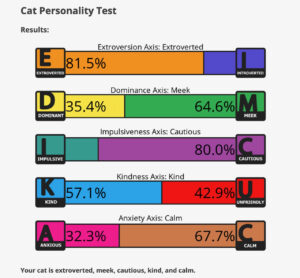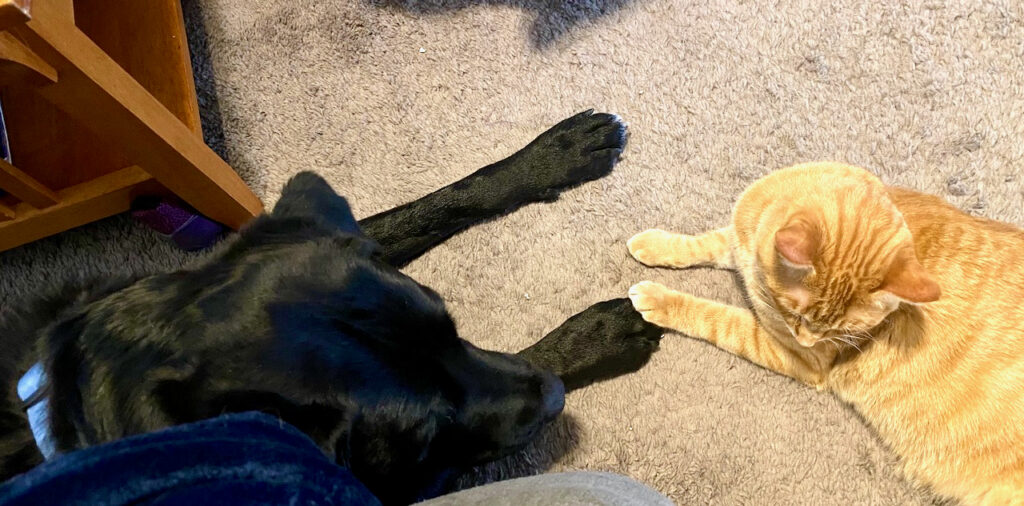 In this post, we look at how cats get along with other species – are their behaviors affiliative or is there conflict?
In this post, we look at how cats get along with other species – are their behaviors affiliative or is there conflict?
How cats get along with other species
How Cats Get Along with People: Signs of Affiliation
In an interview with Terry Gross of the NPR show, “Fresh Air”, the well-known anthrozoologist, John Bradshaw, noted that cats view their owners as cats, specifically cats they are affiliated or friendly with. Cats greet us as they would an affiliated cat, rubbing up against us, touching their noses to our hands, licking our hands and faces, snuggling next to us in bed at night.
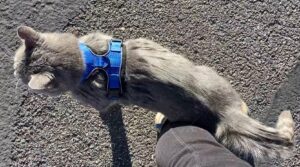 Cats use the same friendly behaviors when interacting with people as they do with other cats.
Cats use the same friendly behaviors when interacting with people as they do with other cats.
- nearness
- rubbing up a person’s legs (allorubbing)
- bunting against our hands (nose touching)
- licking hands (allogrooming)
- approaching with tail up
How Cats Get along with people: Signs of Conflict
Cats show similar conflict behaviors when interacting with humans that they would use with other cats.
- staring
- stalking and pouncing
- running away
- biting, swatting and swiping
- arched back and hair standing on end
Young cats in particular can be guilty of stalking and pouncing on owners as they round a corner in the house. Some of these behaviors can be the result of playing with the cat inappropriately or redirected aggression, where the cat associates the owner with a fearful experience.
A petting session sometimes comes to an end when the cat bites or swats the person petting him, then jumps down and runs away. It is important to add to the list above some “pre-conflict” behaviors that we must watch for:
- flattened ears
- fur on the cat’s back ripples
- the cat turns to face you with a stare
How Cats Get along with Children
Cats showed no preference to gender or age when meeting volunteers in a shelter for the first time. The volunteers did not interact with the cats but instead read an age-appropriate book. [Turner, The Mechanics of Social Interactions Between Cats and Their Owners]
After 5 minutes, the volunteers were allowed to interact as they pleased with the cats. The cats reacted strongly to the differences in behavior between men, women and children. Women and girls tended to move onto the floor with the cat and speak quietly; men remained seated, and boys approached the cats immediately, causing them to run away. [See below Turner].
Children, being more active, and less attentive to the body language of cats, tend to elicit more conflict behaviors from cats then adults. Children playing with cats must be supervised by adults as young children, in an excess of enthusiasm, may hit the cat with a toy or chase them.
A cat’s impulse is to flee when chased by a child but if cornered, he may bite or scratch. It is important to allow cats avenues to escape the attention of boisterous youngsters – high cat trees or closets with latches that allow the cat access but not the child.
How Cats Get Along: Cats and Dogs
Although cartoons and films may show cats and dogs as mortal enemies, many co-exist peacefully in human homes.
A recent survey based study by Thomsen et al. (cited below), indicated that the success of the relationship depends on the age of the cat (preferably around 6 months) when introduced to the dog. Ideally, good experiences with friendly, well-behaved dogs during the cat’s “sensitive” period will predispose the cat to forming relationships with dogs. Slow, gradual introductions between cat and dog (similar to Introducing Cats) have the best chance at success
Just like with humans, cats tend to show the same behaviors to dogs they are friendly with that they would show to other cats.
- sleep in the same room as the dog, sometimes touching
- rub against the dog when greeting
- approach with tail up
Although a dog may be affiliated with the cat in his house, this does not mean he will not chase or bark at a strange cat. A cat who has been raised with dogs may still turn and flee from dogs he does not know. Affiliation exists between individual animals, not a whole species.
Dogs also have a set of affiliative behaviors. The hallmarks of a well-socialized dog include:
- relaxed body
- rapid tail wag
- no staring
- indirect approach, looking and sniffing at the ground
Canine conflict behaviors include:
- backing away or trying to escape
- submissive behaviors: flattened ears, tail tucked, looking away
- staring, growling, snapping, erect posture
- tail held vertically or arched over the back
Another survey-based study (Menchetti et al. cited below) compared owners’ perceptions of how dogs and cats living in their homes get along. Owners felt that:
- Dogs are more social than cats towards strange animals and humans
- Dogs are more playful than cats with their owners
- More dogs lick the cat than vice versa
- More cats ignore the dog than vice versa
- Most dogs and cats in the same household will sleep together and play together at least occasionally
- Although cats and dogs have different body languages, they still manage to understand each other
 A Tale of Tails
A Tale of Tails
Both cats and dogs use their tails to communicate.
| Cats | Dogs | |
|---|---|---|
| Friendly Gesture | Tail up | Tail wagging |
| Conflict | Tail twitching | Tail up |
Somehow, cat-dog pairs translate each other’s language. The cat approaches the dog for a nose-to-nose greeting with tail up and lies down beside him. The dog recognizes the cat’s behaviors as positive signals and he wags his tail.
When the dog approaches the cat with the tail up, the cat recognizes the conflict/aggressive signal, arches his back, twitches his tail and backs slowly away.
Cats will use the same visual signals that they use with other cats when interacting with other species, such as humans and dogs. It is important that we, as pet guardians, know and understand the affiliative and conflict behaviors of each species residing in our homes to prevent altercations and promote peaceful coexistence.
CITATIONS:
Menchetti L, Calipari S, Mariti C, Gazzano A, Diverio S. Cats and dogs: Best friends or deadly enemies? What the owners of cats and dogs living in the same household think about their relationship with people and other pets. PLoS One. 2020 Aug 26;15(8):e0237822. doi: 10.1371/journal.pone.0237822. PMID: 32845923; PMCID: PMC7449504
Jessica E. Thomson, Sophie S. Hall, Daniel S. Mills, Evaluation of the relationship between cats and dogs living in the same home, Journal of Veterinary Behavior, vol 27 2018, Volume 35-40 ISSN 1558-7878, https://doi.org/10.1016/j.jveb.2018.06.043.
Turner DC (2021) The Mechanics of Social Interactions Between Cats and Their Owners Front. Vet. Sci. 8:650143 doi: 10.3389/fvets.2021.65014
Want to keep up with the world of cats? Subscribe to The Feline Purrspective!

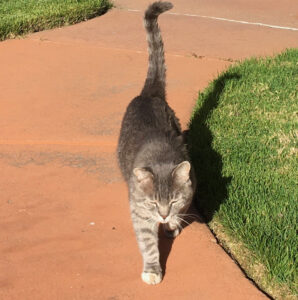 A Tale of Tails
A Tale of Tails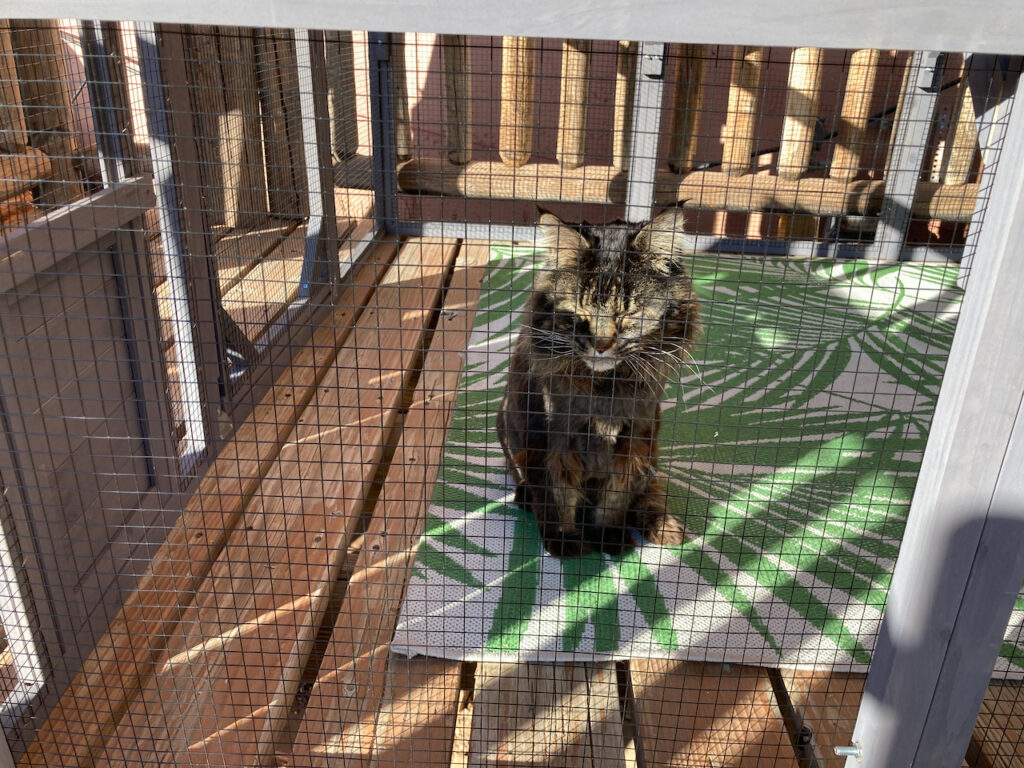 In the U.S., it has become common to keep cats solely indoors. Indoor cats live longer – they are not run over by cars, hunted by coyotes, or injured in cat fights.
In the U.S., it has become common to keep cats solely indoors. Indoor cats live longer – they are not run over by cars, hunted by coyotes, or injured in cat fights.



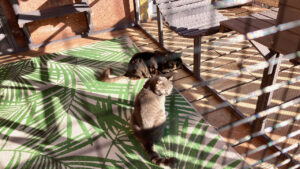
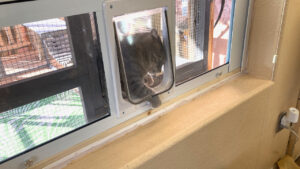
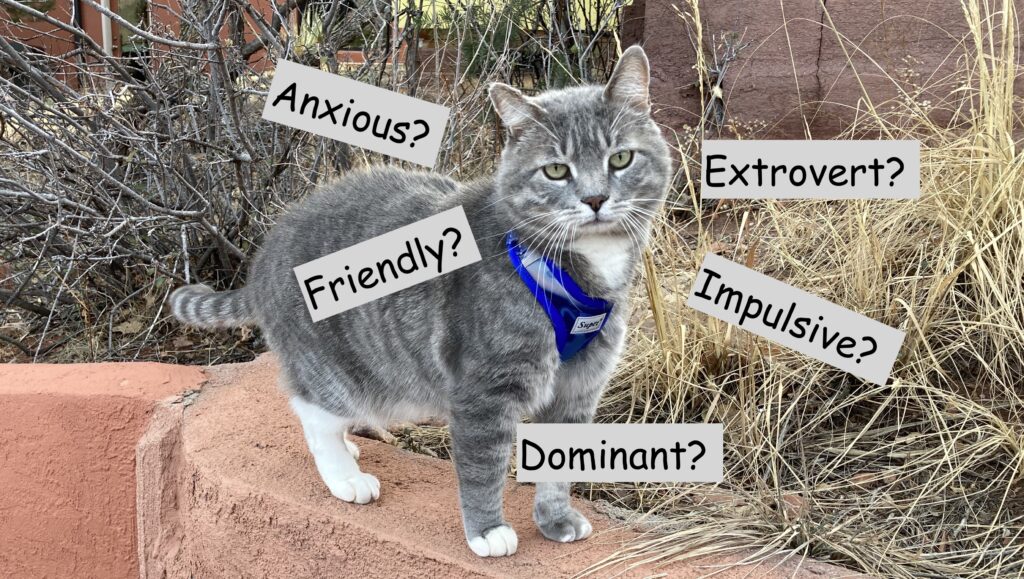 Do cats have personalities? If you
Do cats have personalities? If you 